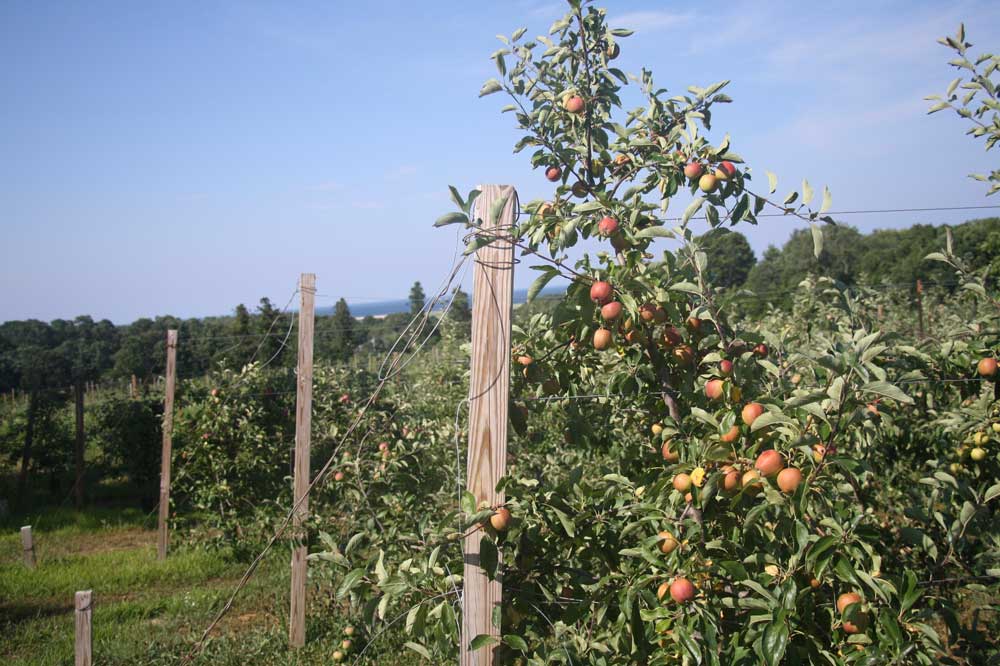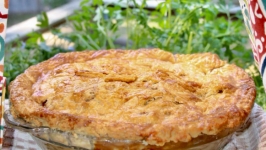Mom and Apple Pie
Apple pie. It’s a Fourth of July must-have, an enduring autumn tradition, and delicious à la mode.
If you asked a soldier in the Second World War what he was fighting for and what he missed the most, he would most likely have answered, “Mom and apple pie.” Together, these two classics conjure our coziest shared Americana, and in these challenging times, what could be more comforting than apple pie to bake and share?
Locally, my mother’s apple pie is a long-time staple in Barnstable Village, where you still find ancient apple trees from forgotten orchards heavy with fruit as summer drifts to fall. These apple trees, which dot the fields and woods of Cape Cod, have a story to tell. None of them are any more native to the region than the notion of pie, and they invite an interesting question: How did apple pie come to Cape Cod, where it takes such an important part in our national and local mythology?
Well, things can be as American as apple pie, but, in a beautiful reflection of America’s melting pot, apple pie is not exclusively American.
Apple pie pops up in the food traditions of many cultures, and the first printed recipe, from England’s Geoffrey Chaucer, dates to 1381. There is nothing like reading Chaucer to make the 14th century come alive, and his apple pie recipe is no exception. While he calls, reasonably enough, for apples, spices, and raisins, he also includes figs and pears, with saffron for color. Things get really interesting with his instructions to wrap the resulting mixture in a “cofyn.” What Chaucer calls a coffin is our pastry crust, and, just to make sure you’re paying attention, he overlooks any kind of sweetener.
In the Netherlands, you can find beautiful, deep, sweet cinnamon apple pies with a buttery, almost cake-like crust in any café. The first Dutch recipe dates to the 16th century, and apple pie first appears in Dutch art in the early 17th century. Usually packed with raisins, Dutch apple pie comes topped with heavy whipped cream, alongside a cup of strong black coffee to cut the sweetness perfectly.
This year, as we celebrate the four hundred years from 1620 to 2020, it’s fun to remember that pie, too, came to New England aboard the Mayflower. The Pilgrims, having lived in both England and the Netherlands, arrived on local shores well steeped in pie tradition, but they must have been dismayed to find only the humble crabapple growing locally.
Respected by Native Americans as a powerful diuretic, the Crab apple, also known as the Common apple, is the only apple native to North America. It is small, bitter, and hard to eat. Next time you call a cranky person “crabby,” remember the Crab apple, and look no further for the origin of the phrase “green apple two-step.”
While apples had been grown in the colony of Jamestown a few years earlier for cider, the earliest known cultivated apples arrived in New England in 1623, probably aboard the supply ship Anne. By 1625, Reverend William Blaxton in Boston had kicked off New England’s long-standing apple-growing tradition by planting the first apple orchard in North America. His Yellow Sweeting, renamed the Rhode Island Greening when he left his Beacon Hill farm for Rhode Island to escape Puritan intolerance, was most probably the first apple cultivar in the New World.
The early colonists got a lot of mileage from their apples. They made cider vinegar and apple cider, as well as hard cider, called AppleJack, which could double as an antiseptic. Along with honey, the apple added rare sweetness to the food of early new England, and finally, people could make apple pies.
The earliest colonial apple pie recipes remained encoffined as Chaucer instructed. In New England, in the era before pie pans, the coffin was made of a very hard dough and served as the baking dish. Apparently, it was often too hard a shell to eat as a crust. But the passage of time made the apple pie increasingly recognizable.
An 1845 recipe in The New England Economical Housekeeper, by H.W. Derby, renders one nine-inch pie with a double crust filled with apples.
In 1911, the Barnstable Village Improvement Society published What We Eat on Cape Cod with a recipe by Mrs. E.A. Handy for Wholesome Apple Pie:
Slice apples thin to fill a pie plate heaping full. Add one cup sugar and half a level teaspoon each of cinnamon and nutmeg. Cover with a good pie paste and bake one hour in a moderate oven. Just before putting it in the oven dash some cold water over the crust. It will make it flaky and crisp.
Apple pie hasn’t changed much since at least 1845, as both of these recipes are pretty much the same as my mother’s. The only real difference is that where Mrs. Handy and mom call for white or brown sugar, the New England Economical Housekeeper calls for molasses. So, if you want to try the 1845 recipe, just switch the sugar for molasses.
I’ve made some good pies from the old apple trees you come across in the local woods and fields. Alternatively, the apple harvest at Crow Farm in Sandwich starts in mid-July, so you don’t have to wait for fall proper to bake your own locally-sourced apple pie.
At Crow Farm, you can find some of the earliest heirloom varieties from New England, including Cortland, MacIntosh, Honey Crisp, and Macoun. Crow Farm is known for its apple picking, and the apple season runs right through mid-December, so you can plan on their apples for your Thanksgiving pies, as well.
There is perhaps nothing more comforting than the smell of a homemade apple pie in the oven, and perhaps no quicker way than sharing one to remind us of our connection and common tradition. If you do make an apple pie, make sure you plop a big scoop of vanilla ice cream on top from Four Seas or Cape Cod Creamery and see if maybe the neighbors want a piece, too.






